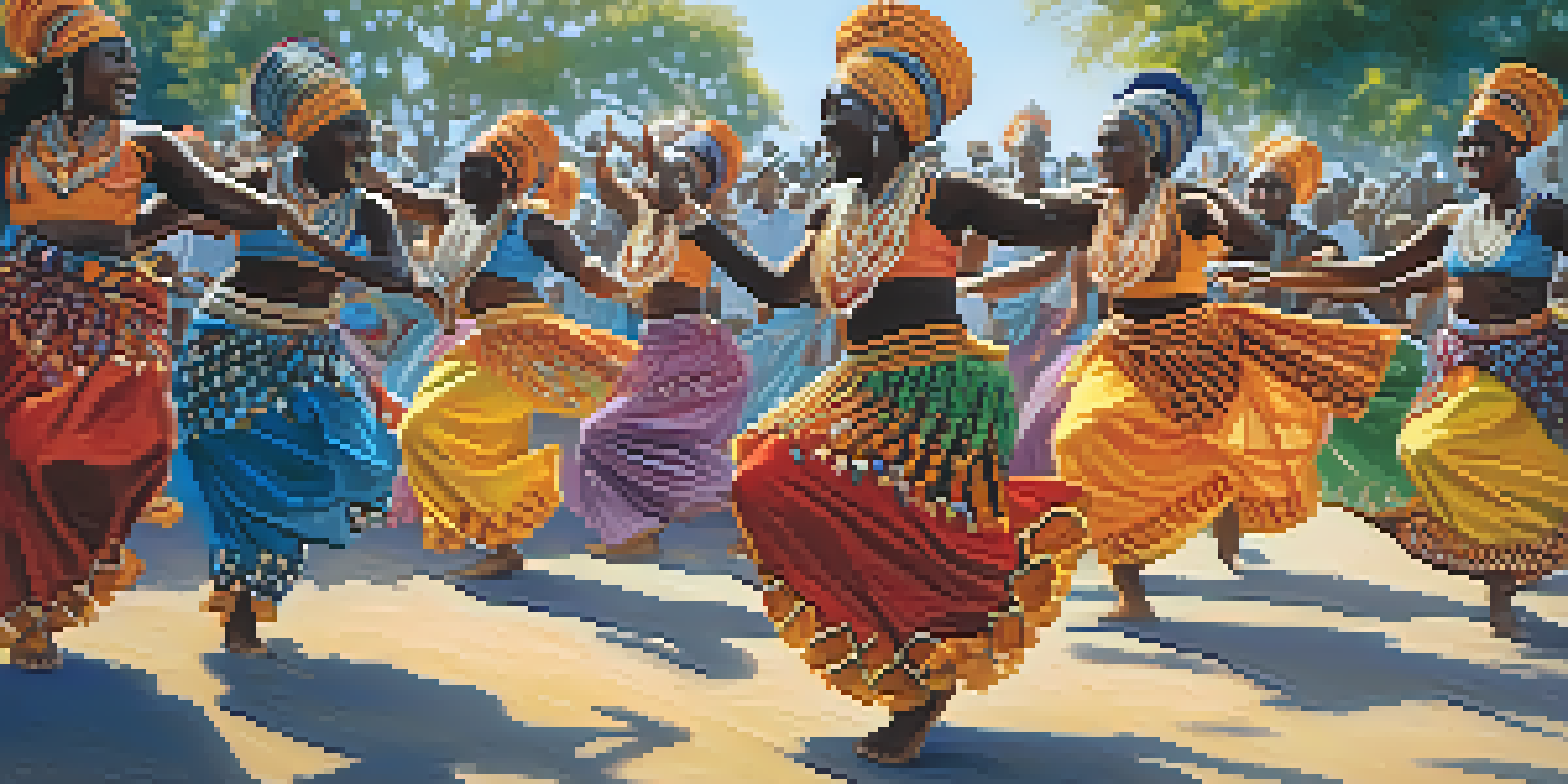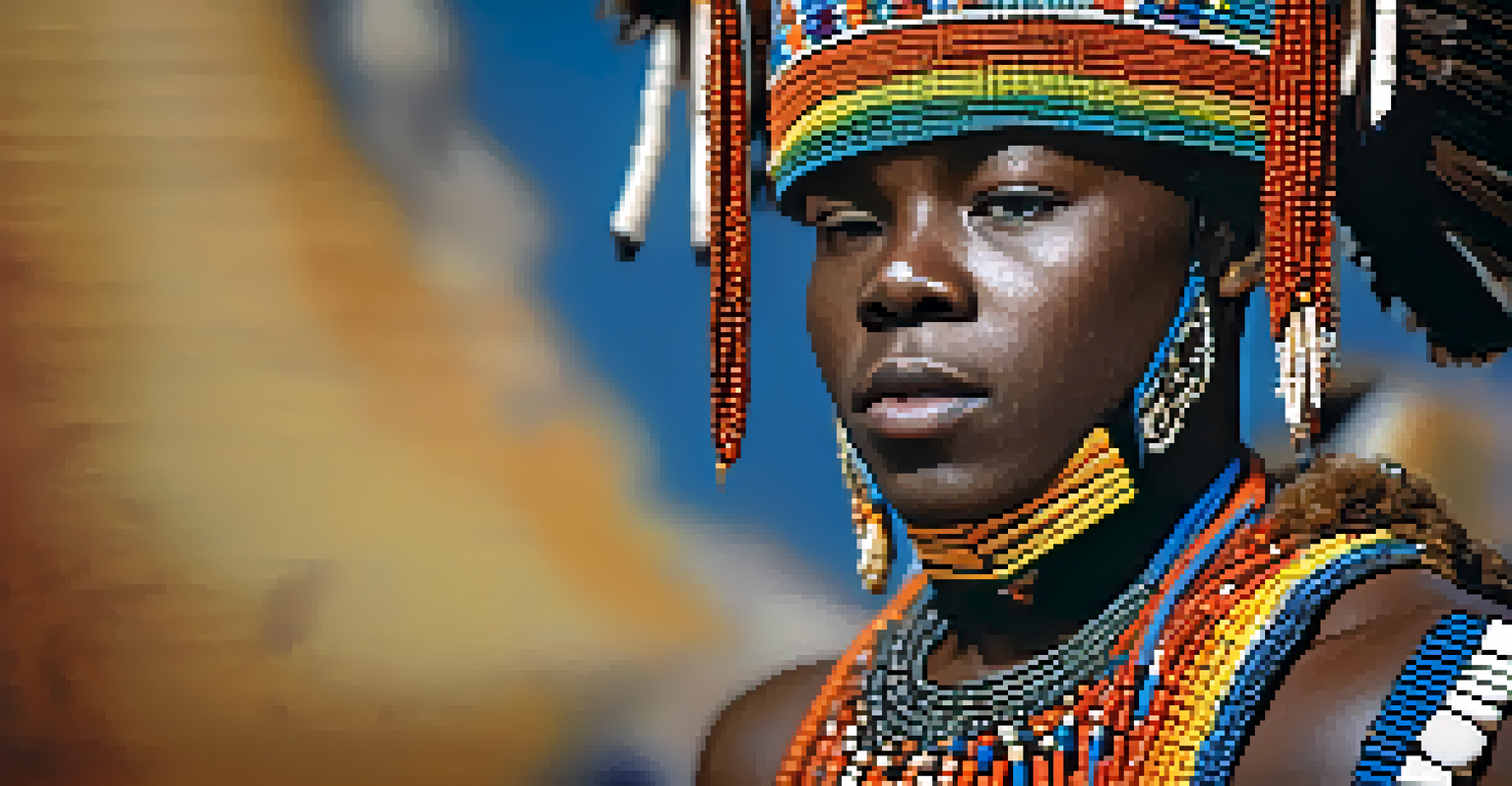Sacred Movements: Dance in African Tribal Rituals Explained

Understanding the Role of Dance in African Cultures
Dance in African cultures is more than just movement; it's a vital expression of identity and community. Each tribe has its own unique styles and rhythms that convey stories, traditions, and beliefs. This art form serves as a bridge connecting generations, allowing the past to be honored and the present to be celebrated.
Dance is the hidden language of the soul.
For instance, in the Yoruba tribe of Nigeria, dance is integral to religious ceremonies and festivals. The movements often tell stories of creation, ancestors, and deities, making the dance a living history lesson. Through these performances, participants not only entertain but also educate and preserve their cultural heritage.
Moreover, dance fosters social cohesion. In many African communities, communal dances bring people together, strengthening bonds and encouraging collective participation. This shared experience reinforces a sense of belonging and unity, highlighting the importance of community in African life.
Spiritual Significance of Dance in Rituals
Many African tribal dances are deeply rooted in spirituality, serving as a means to communicate with the divine. Dancers often enter a trance-like state, believed to facilitate a connection with ancestors or spirits. This spiritual dimension elevates the dance from mere performance to a sacred act of worship.

Take the Maasai warriors, for example, who perform the 'Adamu,' a jumping dance during significant ceremonies. This dance is not just a display of athleticism; it is a prayer for strength and blessings. The movements symbolize their connection to the earth and the divine, highlighting the dance’s sacred role.
Dance as Cultural Expression
In African cultures, dance serves as a vital expression of identity, community, and tradition, connecting generations through storytelling.
In this context, dance becomes a form of meditation, allowing participants to transcend the physical realm and experience spiritual enlightenment. Such practices emphasize the belief that through dance, individuals can achieve a deeper understanding of their place in the universe.
Types of Dance in African Tribal Rituals
African tribal dances can be categorized into various types, each serving distinct purposes. Ceremonial dances often occur during rites of passage, such as birth, initiation, or marriage, marking significant life events. These dances are vibrant, filled with colorful attire and powerful rhythms that resonate with the occasion's importance.
To dance is to be out of yourself. Larger, more beautiful, more powerful. You are no longer you; you are the dance.
Social dances, on the other hand, are performed during gatherings, festivals, and celebrations. They offer an opportunity for community members to come together, socialize, and express joy. An example is the 'Gumboot dance' from South Africa, which originated among miners and has evolved into a celebrated communal expression.
Finally, there are healing dances, which are performed to promote physical and spiritual well-being. These dances often involve rhythmic movements and chants meant to invoke healing spirits. They demonstrate how dance serves not only as entertainment but also as a means of addressing health and wellness within the community.
The Instruments That Accompany Dance
Music is an essential element of African dance rituals, with various instruments adding depth and emotion to the performances. Drums, in particular, play a pivotal role, providing the foundational rhythm that guides the dancers. Each beat resonates with the heartbeat of the community, creating a powerful connection between the dancers and the audience.
Instruments like the djembe, shekere, and kalimba contribute a rich tapestry of sounds that enhance the storytelling aspect of the dance. For instance, the djembe's deep, resonant tones can evoke feelings of power and strength, while lighter instruments can add a playful, joyful element to the performance.
Spiritual Connection Through Dance
Many African dances are deeply spiritual, allowing participants to communicate with the divine and achieve a sense of enlightenment.
Moreover, the interaction between musicians and dancers is dynamic and reciprocal. As the dancers move, musicians often adjust their rhythms, creating a live dialogue that enhances the overall experience. This synergy emphasizes the communal nature of African dance, where every participant plays a vital role.
Costumes and Their Symbolism in Dance
Costumes in African tribal dances are not just for show; they are laden with meaning and symbolism. Each garment is often crafted from materials that represent the tribe's history, beliefs, and values. For example, brightly colored fabrics may symbolize joy and celebration, while earthy tones might reflect connection to the land.
In many cultures, specific colors or patterns may be reserved for particular rituals. For instance, the intricate beadwork of the Zulu people often signifies status and identity. During dance performances, these costumes tell stories and convey messages, adding another layer of depth to the ritual.
The process of creating these costumes often involves the entire community, with individuals contributing their skills and creativity. This collective effort not only strengthens community bonds but also ensures that each performance is a unique reflection of the tribe's identity and heritage.
The Impact of Colonialism on African Dance Traditions
Colonialism brought significant changes to African dance traditions, often leading to the suppression of indigenous practices. European colonizers frequently viewed these dances as primitive or uncivilized, resulting in a loss of cultural expression for many tribes. This historical context highlights the resilience of African communities in preserving their dance traditions despite external pressures.
Even as traditional dances faced challenges, many evolved by incorporating elements from colonizers' cultures. This fusion can be seen in contemporary African dance, where traditional movements are blended with modern styles, creating a vibrant and dynamic art form. Such adaptations reflect the ability of African cultures to innovate while staying rooted in their heritage.
Impact of Colonialism on Dance
Colonialism significantly affected African dance traditions, but communities have shown resilience by blending traditional and modern styles to preserve their heritage.
Today, there is a renewed interest in reclaiming and celebrating traditional dances. Efforts are being made to revive and promote these art forms as vital expressions of cultural identity. This resurgence not only honors the past but also empowers future generations to embrace their heritage.
Contemporary Interpretations of African Dance
Modern interpretations of African dance are gaining popularity worldwide, showcasing the beauty and complexity of these traditions. Dancers and choreographers are innovating by blending traditional movements with contemporary styles, creating performances that resonate with global audiences. This fusion allows for a broader appreciation of African culture while keeping it alive and relevant.
For example, the dance group 'Alvin Ailey American Dance Theater' incorporates African dance elements into their performances, celebrating the rich history and diversity of African-American culture. Such initiatives highlight how dance can serve as a powerful medium for cultural exchange and understanding.

Moreover, this contemporary evolution often involves storytelling, addressing current social issues and themes through movement. By doing so, African dance continues to be a living art form, adaptable to changing times while retaining its core values and significance.